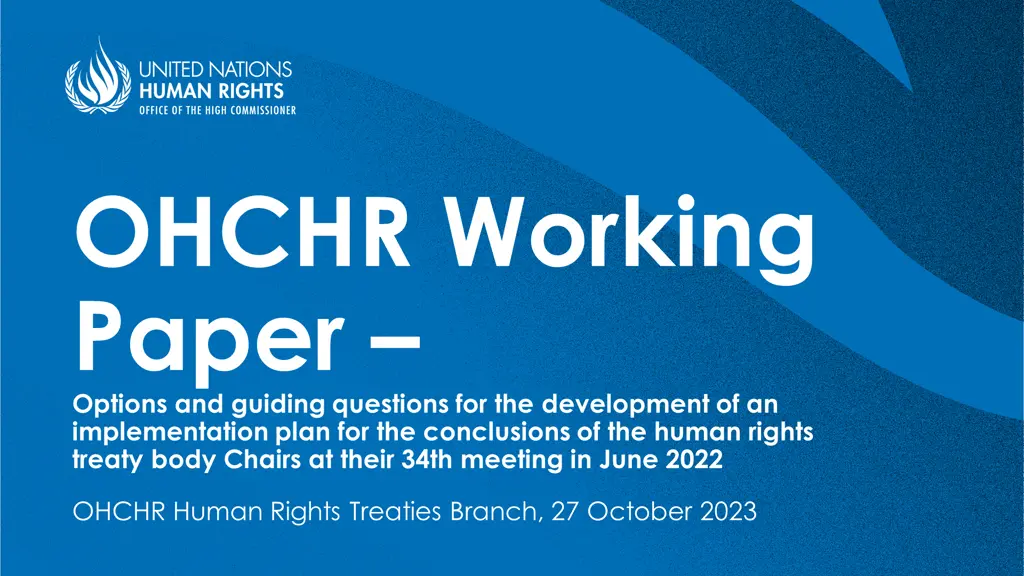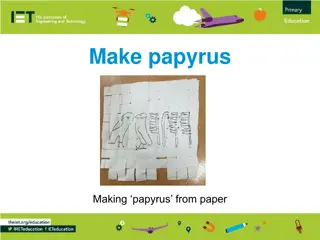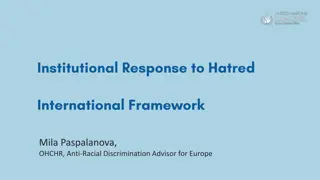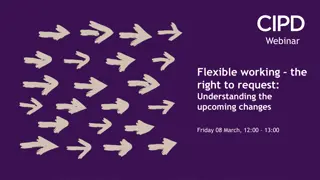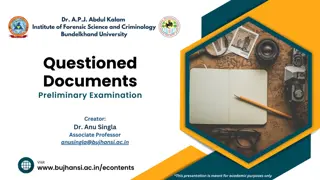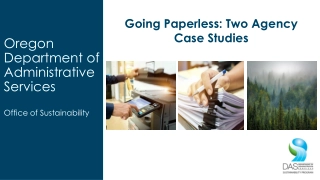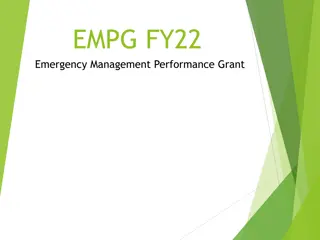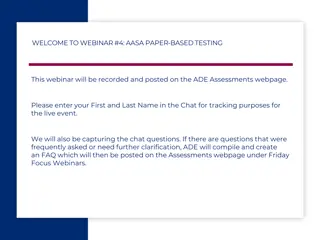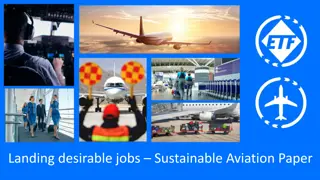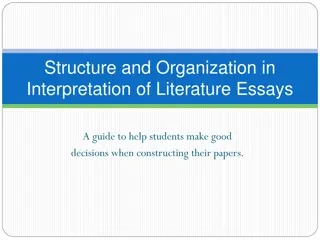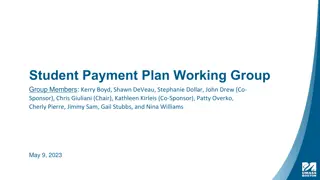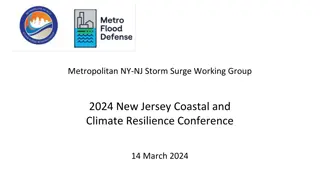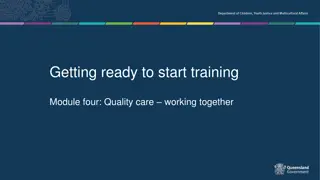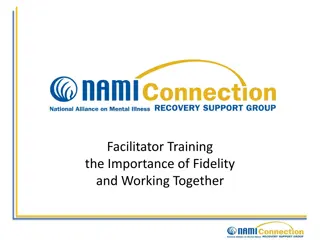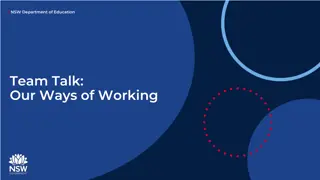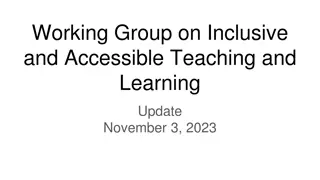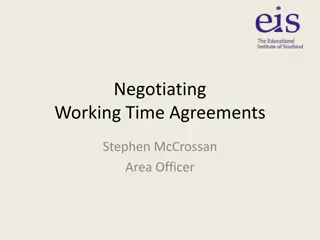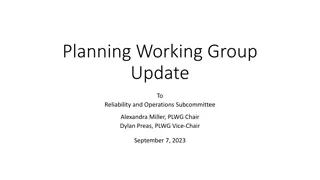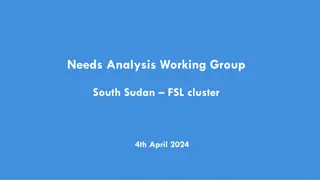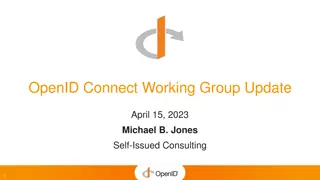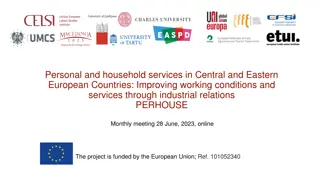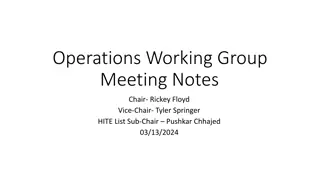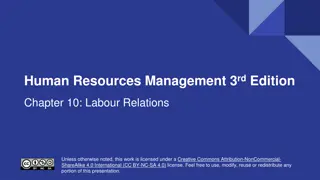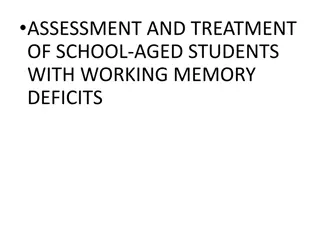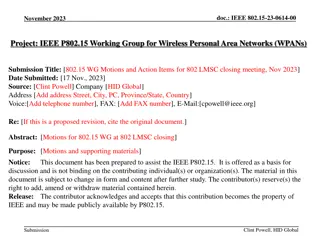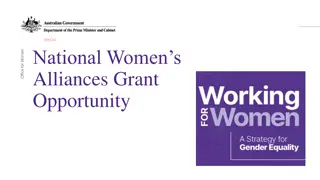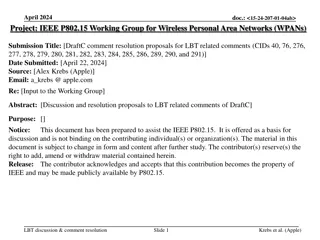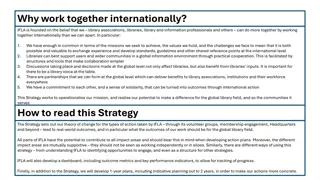OHCHR Working Paper
Working paper outlines options and guiding questions for developing an implementation plan for the conclusions of the human rights treaty body chairs. It provides a framework for strengthening the treaty body system and ensuring predictable reviews.
Download Presentation
Please find below an Image/Link to download the presentation.
The content on the website is provided AS IS for your information and personal use only. It may not be sold, licensed, or shared on other websites without obtaining consent from the author. Download presentation by click this link. If you encounter any issues during the download, it is possible that the publisher has removed the file from their server.
- working paper
- implementation plan
- human rights treaty body
- conclusions
- strengthening process
- predictable schedule
- reviews
Presentation Transcript
OHCHR Working Paper Options and guiding questions for the development of an implementation plan for the conclusions of the human rights treaty body Chairs at their 34th meeting in June 2022 OHCHR Human Rights Treaties Branch, 27 October 2023
Agenda for todays meeting 1. Current developments of the treaty body strengthening process 2. Purpose and approach of the OHCHR Working Paper 3. Pillar I introduction of an 8-year predictable schedule of reviews 4. Pillar II harmonization of working methods 5. Pillar III digital uplift
Current developments of the treaty body strengthening process States are encouraged to: Share their own preferences and concrete answers to the questions contained in the OHCHR Working Paper during the informal briefing on 1 November; 11-year treaty body strengthening process Important milestones in 2022/23, leading up to the next biennial General Assembly resolution in December 2024 Take an active role in any formal and informal consultations on the OHCHR Working Paper to develop converging views on the options contained therein; Informal briefing for States by the High Commissioner for Human Rights on 1 November 2023 (3-6pm Geneva time, Palais des Nations and virtual) Work towards a strong biennial GA resolution in 2024 on the human rights treaty body system that helps to put into practice the conclusions of the Chairs reached at their 2022 and 2023 annual meetings and recommendations of the co-facilitators.
Purpose and approach of the OHCHR Working Paper The OHCHR Working Paper: Was prepared upon request by the treaty body Chairpersons; Is based on OHCHR s overall responsibility, as articulated in GA resolution 48/141 (para. 4) and the recommendations of the co-facilitators of the 2020 review process (A/75/601); Aims to support the implementation for the Chairs conclusions of 2022 by adding the technical details needed; Proposes options and guiding questions, addressed to States and treaty body members within their respective competencies and responsibilities.
Pillar I introduction of an 8-year predictable schedule of reviews
Introduction of an 8-year predictable schedule of reviews Option 1 linear reviews* Why? Replace the unpredictability of the current system and allow States and other stakeholders to plan with certainty and efficiency; Option 2 partial clustering* Ensure the equal treatment of States parties and prevent the accumulation of any future backlog; Provide renewable expert advice and avoid any need to update submitted State party reports; Option 3 full clustering* Increase the complementarity of reviews; reduce the duplication of issues raised by the treaty bodies; and allow States to optimize national consultative processes; Alleviating the workload of States parties with a periodicity of full reviews and follow-up reviews, that strike a balance between timely follow-up on critical issues and the time and resources that need to be invested. * These are illustrative examples for a State party that ratified all eight Covenants/Conventions with periodic reporting obligations; States parties that have ratified less than eight international human rights treaties will have fewer State party reviews in an 8-year cycle.
Follow-up reviews Reviews on up to four priority issues in-between the full reviews Option 1 correspondence-based follow-up review (This option would be similar to the current practice of the CAT, CCPR, CED, CEDAW, CERD, CESCR and CMW Committees.) Option 2 - correspondence-based follow-up review, with an additional constructive dialogue Option 3 - in-situ visit to the State party OHCHR
Harmonization of working methods How? Why? Option 1 continuation of current practices Facilitates engagement by States parties and other stakeholders with the treaty body system; Annual Chair s meeting and ad hoc cooperation Allows States parties and other stakeholders to focus on substantive preparations; Time and cost-saving for coordination, and safeguarding of preferences and specificities of each treaty body Lack of implementation of decisions Shortens duration between the submission of a State party report and its review (avoids updating and allows for timely recommendations); Risk of perpetuating the plethora of different working methods Reduces reporting burden (simplified reporting procedure - focused, short); Option 2 establishment of a coordination mechanism Reduces duplications in concluding observations/lists of issues (prior to reporting); Institutionalization of systematic harmonization of existing and new methods of work Improves accessibility and reasonable accommodation. Substantive coordination on common and intersectional issues (common terminology/interpretation) Leading to coherence and efficiency Benefits States and all other stakeholders alike Confirmed by Chairs conclusions, 35th meeting 2023
Harmonization of working methods Additional options contained in the OHCHR Working Paper Simplified reporting procedure = default procedure (opting out/initial and periodic reports) Common templates, formats and drafting guidelines Common Core Document Modalities of constructive dialogues (duration, format for LDCs/SIDSs, exceptional circumstances) Harmonized modalities for reports submitted by NHRIs and NGOs Joint General Comments/General Recommendations and avoidance of unnecessary duplication Methods of work for individual communications Methods of work on inquiries Accessibly and provision of reasonable accommodation for persons with disabilities, etc.;
Digital uplift How? Why? Facilitate engagement by States and other stakeholders, while still allowing for other formats of submissions for those who do not have access to the necessary digital tools; Increase time efficiency and improve substantive outcomes in the work of treaty bodies; Facilitate capacity-building activities through digital means; Render the treaty body system sufficiently efficient to address its constant growth. A common webpage and database on the simplified reporting procedure (SRP); Common and user-friendly submission and document management platforms that allow easy access to publicly available documents for external audiences; An accessible video conferencing and webcasting platform with interpretation.
Thank you #standup4humanrights OHCHR
